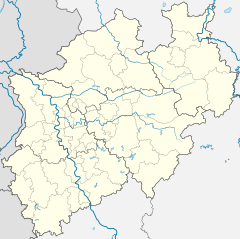German Inland Waterways Museum




The German Inland Waterways Museum (German: Museum der Deutschen Binnenschifffahrt) is located in Ruhrort, Duisburg at the nucleus of Duisburg-Ruhrorter ports, which today make up the largest European inland harbour complex.
The museum was founded in 1974 with the purchase of the museum ship Oscar Huber. In 1998 the museum was moved from the old town hall into the city's former indoor swimming facility, an Art Nouveau landmark which had been built in 1910, closed in 1986, and declared a protected historic site in 1988.[1] The move allowed the museum the space to exhibit complete ships, as well as spurring redevelopment in the harbor area. The building conversion was designed by Architektur Fabrik Aachen (afa) and an American artist, Ron Bernstein, and made very little change to the building exterior while expanding the inner spaces to accommodate the exhibits.[2] For example, a full-size sailing ship now occupies the former men's pool, while the second-story women's pool now houses a reconstructed barge.[3]
References
- ^ "The history of the museum", Duisburg am Rhein official city website (accessed 2014-06-13).
- ^ "The Museum of Inland Shipping" Archived 2014-01-10 at the Wayback Machine, Museum für Architektur und Ingenieurkunst NRW (accessed 2014-06-13).
- ^ "Museum der Deutschen Binnenschifffahrt – Duisburg", baukunst-nrw (accessed 2014-06-13).
External links
 Media related to Museum der Deutschen Binnenschifffahrt at Wikimedia Commons
Media related to Museum der Deutschen Binnenschifffahrt at Wikimedia Commons
- Museum website (English)
- Museum website (German only)
- Museum Restaurant website (German only)
51°27′36″N 6°43′48″E / 51.46000°N 6.73000°E / 51.46000; 6.73000
- v
- t
- e
anchor points
- German Inland Waterways Museum
- Duisburg Inner Harbour
- Oberhausen Industrial Museum
- Landschaftspark Duisburg-Nord
- Gasometer Oberhausen
- Aquarius Water Museum
- Villa Hügel
- Nordsternpark
- World Heritage Site Zeche Zollverein
- Marl Chemical Park
- Bochum Dahlhausen Railway Museum
- Henrichshütte
- Centennial Hall Bochum
- Recklinghausen Substation
- German Mining Museum
- Zeche Nachtigall
- Henrichenburg boat lift
- German Occupational Safety Exhibition (DASA)
- Hansa Coking Plant
- Zeche Zollern II/IV
- Hohenhof
- Hagen Open-air Museum
- Lindenbrauerei Unna
- Maximilianpark Hamm
- Halde Rheinpreußen

- Duisburg: Town and Harbour
- Zollverein Industrial Landscape
- Duisburg: Industrial Culture on the Rhine
- Oberhausen: Industry makes the Town
- Krupp and the Town of Essen
- Dortmund: Dreiklang Coal, Steel and Bier
- Industrial Culture on the Lippe
- Erzbahn-Emscherbruch
- Industrial Culture at Volme and Ennepe
- Brine, Steam and Coal
- Early Industrialisation
- The History and the Present of the Ruhr
- On the Way to the Blue Emscher
- Canals and Shipping
- Railways in the Area
- Westphalia Mining Route
- Rhenish Mining Route
- Chemistry, Glass and Energy
- Workers' Settlements
- Entrepreneurial Villas
- Bread, Grain and Beer
- Myth of the Ruhr Region
- Historic Parks and Gardens
- Industry/Nature
- Panoramas and Landmarks
- Sacred Buildings
- Iron and Steel
- Water: Works, Towers and Turbines
- Bochum: Industrial Culture in the Heart of the Region
- Ruhr Industrial Heritage Trail – Gelsenkirchen (in preparation)
Ruhr Industrial Heritage Trail by bike
 | This article about a North Rhine-Westphalian building or structure is a stub. You can help Wikipedia by expanding it. |
- v
- t
- e









